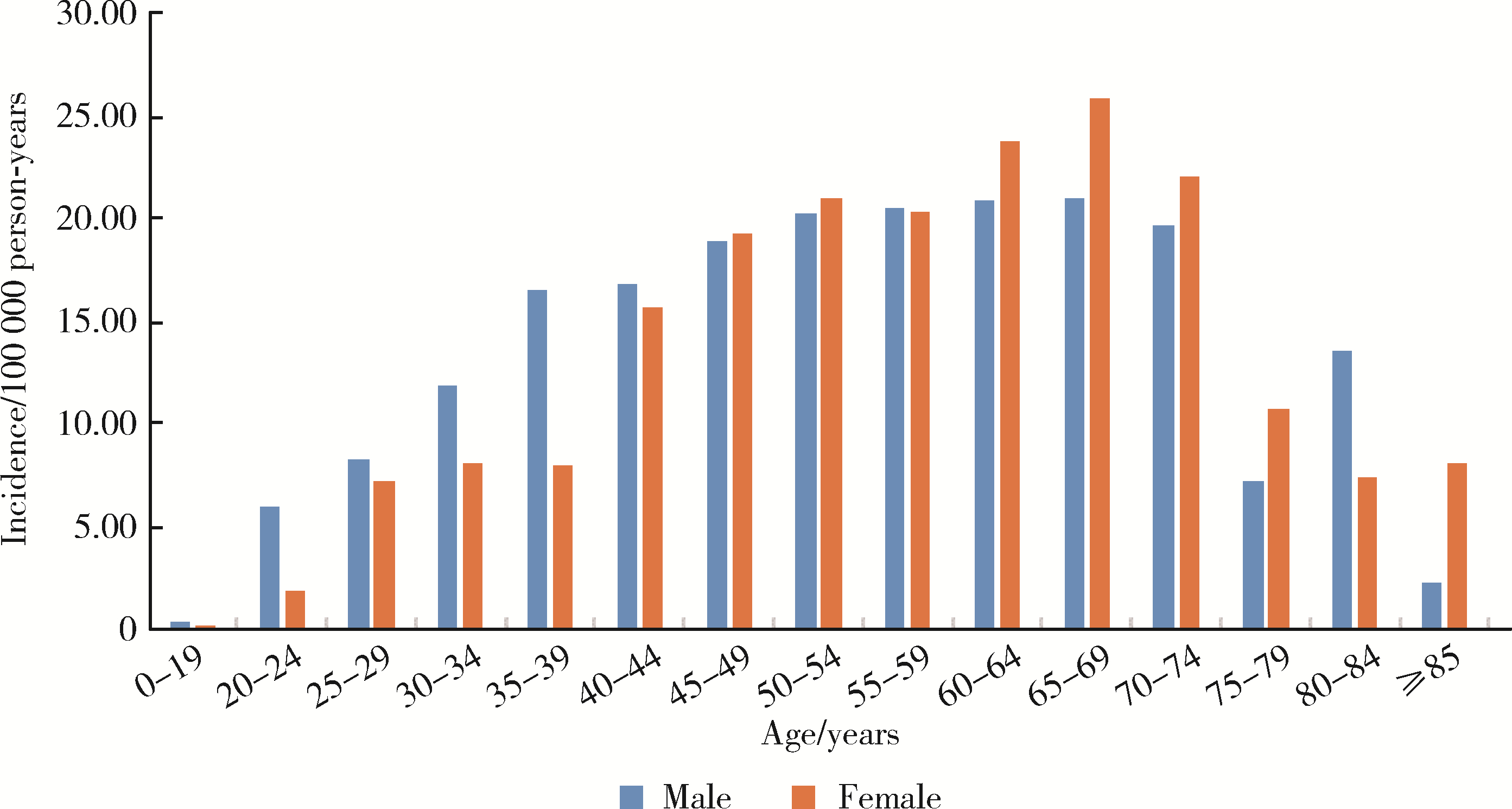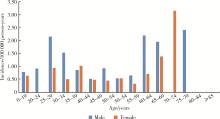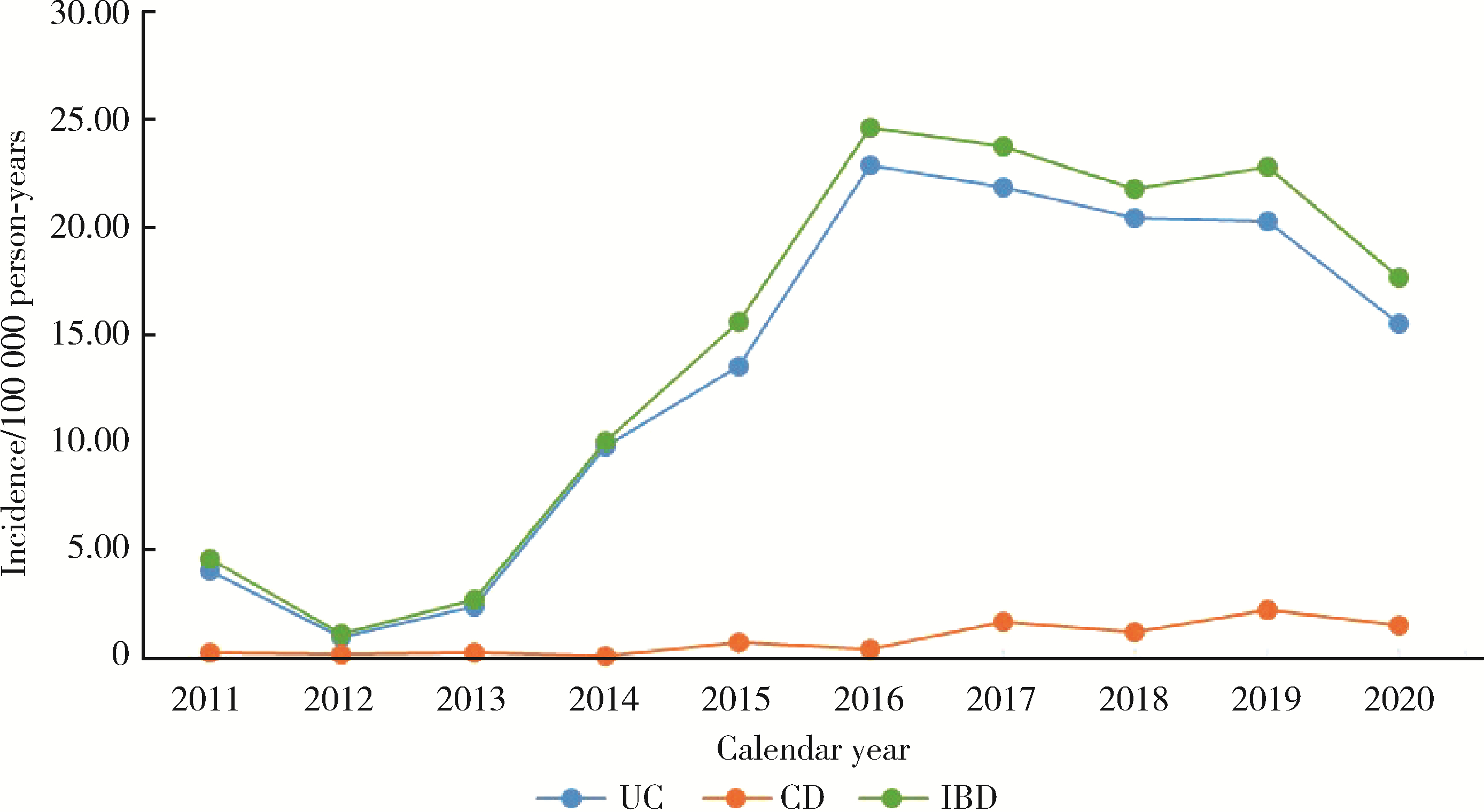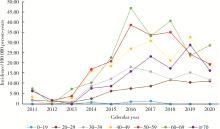Journal of Peking University (Health Sciences) ›› 2022, Vol. 54 ›› Issue (3): 511-519. doi: 10.19723/j.issn.1671-167X.2022.03.017
Previous Articles Next Articles
Epidemiological study on the incidence of inflammatory bowel disease in Yinzhou District, Ningbo City from 2011 to 2020
Bing-jie HE1,Zhi-ke LIU1,Peng SHEN2,Ye-xiang SUN2,Bin CHEN3,Si-yan ZHAN1,4,*( ),Hong-bo LIN2,*(
),Hong-bo LIN2,*( )
)
- 1. Department of Epidemiology and Biostatistics, Peking University School of Public Health, Beijing 100191, China
2. Yinzhou District Center for Disease Control and Prevention, Ningbo 315199, Zhejiang, China
3. Ningbo Anorectal Hospital, Ningbo 315048, Zhejiang, China
4. Institute for Artificial Intelligence, Peking University, Beijing 100191, China
CLC Number:
- R181.2
| 1 | 葛均波, 徐永健. 内科学[M]. 8版 北京: 人民卫生出版社, 2013: 385- 393. |
| 2 |
中华医学会消化病学分会炎症性肠病学组. 炎症性肠病诊断与治疗的共识意见(2012年·广州)[J]. 胃肠病学, 2012, 17 (12): 763- 781.
doi: 10.3969/j.issn.1008-7125.2012.12.013 |
| 3 |
张玉洁, 梁洁, 吴开春. 炎症性肠病诊断与治疗的共识意见(2018年, 北京)溃疡性结肠炎部分解读[J]. 中华消化杂志, 2018, 38 (5): 312- 314.
doi: 10.3760/cma.j.issn.0254-1432.2018.05.003 |
| 4 |
Ungaro R , Mehandru S , Allen PB , et al. Ulcerative colitis[J]. Lancet, 2017, 389 (10080): 1756- 1770.
doi: 10.1016/S0140-6736(16)32126-2 |
| 5 |
冉志华, 童锦禄. 炎症性肠病诊断与治疗的共识意见(2018年, 北京)克罗恩病部分解读[J]. 中华消化杂志, 2018, 38 (5): 315- 317.
doi: 10.3760/cma.j.issn.0254-1432.2018.05.004 |
| 6 |
Torres J , Mehandru S , Colombel JF , et al. Crohn's disease[J]. Lancet, 2017, 389 (10080): 1741- 1755.
doi: 10.1016/S0140-6736(16)31711-1 |
| 7 |
Alatab S , Sepanlou SG , Ikuta K , et al. The global, regional, and national burden of inflammatory bowel disease in 195 countries and territories, 1990—2017: a systematic analysis for the Global Burden of Disease Study 2017[J]. Lancet Gastroenterol Hepatol, 2020, 5 (1): 17- 30.
doi: 10.1016/S2468-1253(19)30333-4 |
| 8 |
李学锋, 彭霞, 周明欢. 我国炎症性肠病流行病学研究进展[J]. 现代消化及介入诊疗, 2020, 25 (9): 1265- 1267.
doi: 10.3969/j.issn.1672-2159.2020.09.032 |
| 9 | Qiu Y , Ren W , Liu Y , et al. Disease burden of inflammatory bowel disease in China from 1990 to 2017: findings from the Glo-bal Burden of Diseases 2017[J]. E Clin Med, 2020, 27, 100544. |
| 10 |
中华医学会消化病学分会炎症性肠病学组. 炎症性肠病诊断与治疗的共识意见(2018年·北京)[J]. 中华炎性肠病杂志, 2018, 2 (3): 173- 190.
doi: 10.3760/cma.j.issn.2096-367X.2018.03.005 |
| 11 |
Cui G , Yuan A . A systematic review of epidemiology and risk factors associated with Chinese inflammatory bowel disease[J]. Front Med, 2018, 5, 183.
doi: 10.3389/fmed.2018.00183 |
| 12 |
Li X , Song P , Li J , et al. The disease burden and clinical characteristics of inflammatory bowel disease in the Chinese population: a systematic review and meta-analysis[J]. Int J Environ Res Public Health, 2017, 14 (3): 238.
doi: 10.3390/ijerph14030238 |
| 13 | Qiao Y , Ran Z . Potential influential factors on incidence and pre-valence of inflammatory bowel disease in mainland China[J]. JGH Open, 2019, 4 (1): 11- 15. |
| 14 |
Huang K , Tao S , Zhou X , et al. Incidence rates of health outcomes of interest among Chinese children exposed to selected vaccines in Yinzhou Electronic Health Records: a population-based retrospective cohort study[J]. Vaccine, 2020, 38 (18): 3422- 3428.
doi: 10.1016/j.vaccine.2020.03.013 |
| 15 | 鄞州区普查中心. 鄞州区人口普查公报数据解读[EB/OL]. (2021-05-19)[2021-11-22]. http://www.nbyz.gov.cn/art/2021/5/19/art_1229108054_59071135.html. |
| 16 |
林鸿波, 刘翠丽, 沈鹏, 等. 基于鄞州区域医疗数据的利巴韦林临床使用的分析[J]. 中国药物警戒, 2018, 15 (2): 73- 77.
doi: 10.3969/j.issn.1672-8629.2018.02.003 |
| 17 |
Yang Y , Zhou X , Gao S , et al. Evaluation of electronic healthcare databases for post-marketing drug safety surveillance and pharmacoepidemiology in China[J]. Drug Saf, 2018, 41 (1): 125- 137.
doi: 10.1007/s40264-017-0589-z |
| 18 | 浙江省人民政府. 浙江省人民政府关于调整宁波市部分行政区划的通知[EB/OL]. (2016-09-30)[2021-11-22]. http://www.zj.gov.cn/art/2016/9/30/art_1229017138_64597.html. |
| 19 |
Keyashian K , Dehghan M , Sceats L , et al. Comparative incidence of inflammatory bowel disease in different age groups in the United States[J]. Inflamm Bowel Dis, 2019, 25 (12): 1983- 1989.
doi: 10.1093/ibd/izz092 |
| 20 |
Jung YS , Han M , Kim WH , et al. Incidence and clinical outcomes of inflammatory bowel disease in South Korea, 2011—2014: a nationwide population-based study[J]. Dig Dis Sci, 2017, 62 (8): 2102- 2112.
doi: 10.1007/s10620-017-4640-9 |
| 21 |
Kaplan GG , Windsor JW . The four epidemiological stages in the global evolution of inflammatory bowel disease[J]. Nat Rev Gastroenterol Hepatol, 2021, 18 (1): 56- 66.
doi: 10.1038/s41575-020-00360-x |
| 22 |
Zeng Z , Zhu Z , Yang Y , et al. Incidence and clinical characteristics of inflammatory bowel disease in a developed region of Guangdong Province, China: a prospective population-based study[J]. J Gastroenterol Hepatol, 2013, 28 (7): 1148- 1153.
doi: 10.1111/jgh.12164 |
| 23 |
Yang H , Li Y , Wu W , et al. The incidence of inflammatory bowel disease in Northern China: a prospective population-based study[J]. PLoS One, 2014, 9 (7): e101296.
doi: 10.1371/journal.pone.0101296 |
| 24 | Zhao J , Ng SC , Lei Y , et al. First prospective, population-based inflammatory bowel disease incidence study in mainland of China: the emergence of "Western" disease[J]. Inflamm Bowel Dis, 2013, 19 (9): 1839- 1845. |
| 25 |
Ng SC , Tang W , Ching JY , et al. Incidence and phenotype of inflammatory bowel disease based on results from the Asia-pacific Crohn' s and colitis epidemiology study[J]. Gastroenterology, 2013, 145 (1): 158- 165.
doi: 10.1053/j.gastro.2013.04.007 |
| 26 | 缪佳蓉. 云南省炎症性肠病流行病学特征、环境及复发因素的研究[D]. 云南: 昆明医科大学, 2015. |
| 27 |
Shivashankar R , Tremaine WJ , Harmsen WS , et al. Incidence and prevalence of Crohn's disease and ulcerative colitis in Olms-ted County, Minnesota from 1970 through 2010[J]. Clin Gastroenterol Hepatol, 2017, 15 (6): 857- 863.
doi: 10.1016/j.cgh.2016.10.039 |
| 28 |
Kotze PG , Underwood FE , Damião A , et al. Progression of inflammatory bowel diseases throughout Latin America and the Caribbean: a systematic review[J]. Clin Gastroenterol Hepatol, 2020, 18 (2): 304- 312.
doi: 10.1016/j.cgh.2019.06.030 |
| 29 |
Burisch J , Munkholm P . The epidemiology of inflammatory bowel disease[J]. Scand J Gastroenterol, 2015, 50 (8): 942- 951.
doi: 10.3109/00365521.2015.1014407 |
| 30 |
Mak WY , Zhao M , Ng SC , et al. The epidemiology of inflammatory bowel disease: east meets west[J]. J Gastroenterol Hepatol, 2020, 35 (3): 380- 389.
doi: 10.1111/jgh.14872 |
| 31 |
Loftus EV Jr. , Silverstein MD , Sandborn WJ , et al. Ulcerative colitis in Olmsted County, Minnesota, 1940—1993: incidence, prevalence, and survival[J]. Gut, 2000, 46 (3): 336- 343.
doi: 10.1136/gut.46.3.336 |
| 32 | 浙江统计数据库. 鄞州区地区生产总值统计[EB/OL]. (2021-02-22)[2021-10-22]. http://data.tjj.zj.gov.cn/page/dataquery.simpleMacro/newQuery/newQuery.jsp?getData=nianduData&ddiUrn=urn:ddi:ZJJCKSTAT:a463a4d9-806b-4fcc-8fc9-b43a8ee4298c:1&dataClassific=yandu&sjztId=urn:ddi:ZJJCKSTAT:8c1a842d-cf0b-40b5-b355-ec4c8d90c506:1&sjztB-gq=N&orgCode=330212&proDemo=zj. |
| 33 | 浙江统计数据库. 鄞州区人均生产总值统计[EB/OL]. (2021-02-22)[2021-10-22]. http://data.tjj.zj.gov.cn/page/dataquery.simpleMacro/newQuery/newQuery.jsp?getData=nianduData&ddiUrn=urn:ddi:ZJJCKSTAT:a463a4d9-806b-4fcc-8fc9-b43a8ee4298c:1&dataClassific=yandu&sjztId=urn:ddi:ZJJCKSTAT:8c1a842d-cf0b-40b5-b355-ec4c8d90c506:1&sjztB-gq=N&orgCode=330212&proDemo=zj. |
| 34 |
Chen Y . Perspectives of IBD China: is Crohn's and colitis foundation model a solution to health care issues for the country?[J]. Inflamm Bowel Dis, 2018, 24 (5): 925- 929.
doi: 10.1093/ibd/izy056 |
| 35 |
Ng SC , Shi HY , Hamidi N , et al. Worldwide incidence and pre-valence of inflammatory bowel disease in the 21st century: a syste-matic review of population-based studies[J]. Lancet, 2017, 390 (10114): 2769- 2778.
doi: 10.1016/S0140-6736(17)32448-0 |
| [1] | Zhihan YUE,Na HAN,Zheng BAO,Jinlang LYU,Tianyi ZHOU,Yuelong JI,Hui WANG,Jue LIU,Haijun WANG. A prospective cohort study of association between early childhood body mass index trajectories and the risk of overweight [J]. Journal of Peking University (Health Sciences), 2024, 56(3): 390-396. |
| [2] | Huichao MA,Jun LI,Yongqing WANG. Clinical characteristics of pregnancy complicated with inflammatory bowel disease [J]. Journal of Peking University (Health Sciences), 2024, 56(2): 260-266. |
| [3] | Xiaoqiang LIU,Yin ZHOU. Risk factors of perioperative hypertension in dental implant surgeries with bone augmentation [J]. Journal of Peking University (Health Sciences), 2024, 56(1): 93-98. |
| [4] | Huan YU,Ruo-tong YANG,Si-yue WANG,Jun-hui WU,Meng-ying WANG,Xue-ying QIN,Tao WU,Da-fang CHEN,Yi-qun WU,Yong-hua HU. Metformin use and risk of ischemic stroke in patients with type 2 diabetes: A cohort study [J]. Journal of Peking University (Health Sciences), 2023, 55(3): 456-464. |
| [5] | Tao MA,Yan-hui LI,Man-man CHEN,Ying MA,Di GAO,Li CHEN,Qi MA,Yi ZHANG,Jie-yu LIU,Xin-xin WANG,Yan-hui DONG,Jun MA. Associations between early onset of puberty and obesity types in children: Based on both the cross-sectional study and cohort study [J]. Journal of Peking University (Health Sciences), 2022, 54(5): 961-970. |
| [6] | LIU Jie,GUO Chao. A prospective cohort study of the influence of positive/negative effectivity on the mortality risk of the Chinese elderly [J]. Journal of Peking University (Health Sciences), 2022, 54(2): 255-260. |
| [7] | YAO Xiao-ying,LIU Zhi-ke,LI Ning,MA Rui,ZHAO Xue-fei,ZHANG Liang,XU Guo-zhang,ZHAN Si-yan,FANG Ting. Epidemiological study of infantile epilepsy incidence density among infants under 36 months of age in Ningbo City from 2015 to 2019 [J]. Journal of Peking University (Health Sciences), 2021, 53(3): 485-490. |
| [8] | LIU Xiao-qiang,YANG Yang,ZHOU Jian-feng,LIU Jian-zhang,TAN Jian-guo. Blood pressure and heart rate changes of 640 single dental implant surgeries [J]. Journal of Peking University (Health Sciences), 2021, 53(2): 390-395. |
| [9] | Huan LIU,Ying-dong HE,Jin-bo LIU,Wei HUANG,Na ZHAO,Hong-wei ZHAO,Xiao-hua ZHOU,Hong-yu WANG. Predictive value of vascular health indicators on newly cardiovascular events: Preliminary validation of Beijing vascular health stratification system [J]. Journal of Peking University (Health Sciences), 2020, 52(3): 514-520. |
| [10] | Wen-ying MENG,Wan-tong HUANG,Jie ZHANG,Ming-yuan JIAO,Lei JIN,Lei JIN. Relationship between serum vitamin E concentration in first trimester and the risk of developing hypertension disorders complicating pregnancy [J]. Journal of Peking University (Health Sciences), 2020, 52(3): 470-478. |
| [11] | Xun TANG,Du-dan ZHANG,Xiao-fei LIU,Qiu-ping LIU,Yang CAO,Na LI,Shao-ping HUANG,Hui-dong DOU,Pei GAO,Yong-hua HU. Application of the China-PAR stroke risk equations in a rural northern Chinese population [J]. Journal of Peking University (Health Sciences), 2020, 52(3): 444-450. |
| [12] | Jun LI,Zhan-yue NIU,Yan XUE,Xue-ying SHI,Bo ZHANG,Yuan WANG. Kaposi sarcoma combined with severe ulcerative colitis: A case report and literature review [J]. Journal of Peking University (Health Sciences), 2020, 52(2): 373-377. |
| [13] | Ting-ting WANG,Ying HAN,Fang-fang GAO,Lei YE,Yu-jun ZHANG. Effects of circular RNA circ-SOD2 on intestinal epithelial barrier and ulcerative colitis [J]. Journal of Peking University(Health Sciences), 2019, 51(5): 805-812. |
| [14] | LIN Hong-bo, CHEN Yi, SHEN Peng, LI Xiao-yong,SI Ya-qin, ZHANG Du-dan, TANG Xun, GAO Pei. Incidence and risk factors of chronic kidney disease in community-based patients with diabetes [J]. Journal of Peking University(Health Sciences), 2018, 50(3): 416-421. |
| [15] | YANG Yu, ZHAO Hou-yu, ZHAN Si-yan. Necessity and feasibility of data sharing of cohort studies#br# #br# [J]. Journal of Peking University(Health Sciences), 2018, 50(2): 381-385. |
|
||







